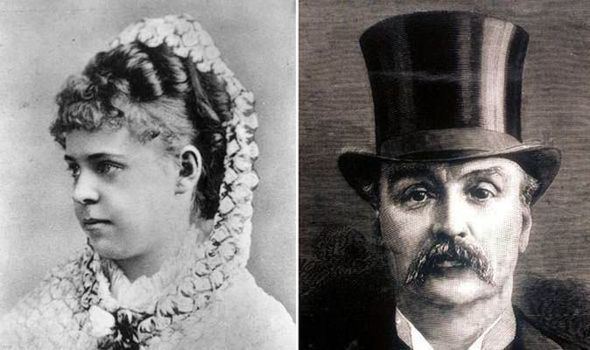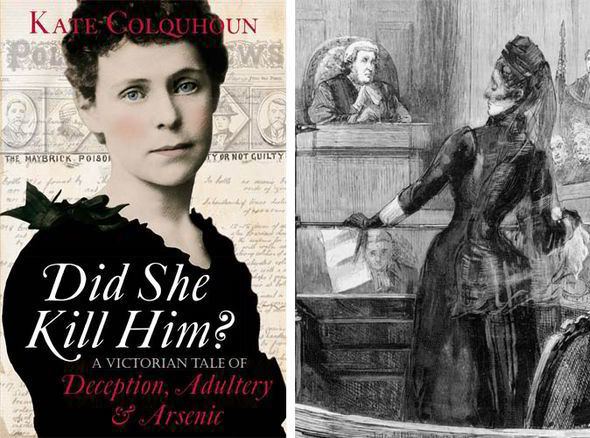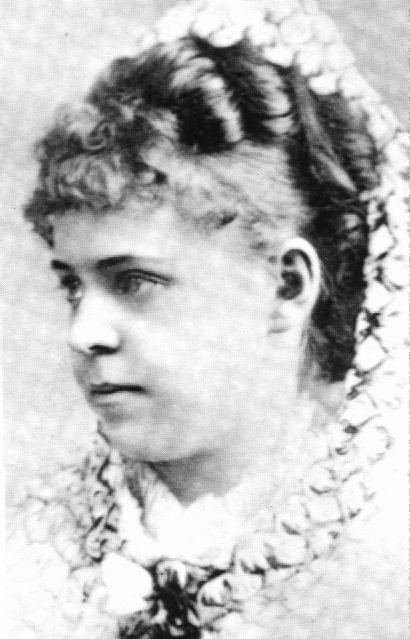Name Florence Maybrick | ||
 | ||
Died October 23, 1941, South Kent, Connecticut, United States | ||
Dceased florence maybrick prod afta 1
Florence Elizabeth Maybrick (3 September 1862 – 23 October 1941) was an American woman convicted in Great Britain of murdering her husband, James Maybrick.
Contents
- Dceased florence maybrick prod afta 1
- Liverpool Murders The Florence Maybrick Case by Vincent Burke
- Early life
- Murder charge
- Time at Woking Convict Prison
- Release
- Non fiction books and pamphlets about the case
- Other works on the case
- Fiction inspired by the case
- References

Liverpool Murders - The Florence Maybrick Case by Vincent Burke
Early life

She was born Florence Elizabeth Chandler in Mobile, Alabama, the daughter of William George Chandler, a partner in the banking firm of St. John Powers and Company, and at one time mayor of Mobile. Her father died, and her mother Caroline Chandler Du Barry, née Holbrook, remarried a third time in 1872 to Baron Adolph von Roques, a cavalry officer in the Eighth Cuirassier Regiment of the German Army. While travelling to Britain with her mother, she met cotton broker James Maybrick on board ship. Other passengers were either amused or shocked by a 19-year-old girl spending so much time alone in the company of Maybrick, who was 23 years her senior. On 27 July 1881, they were married at St James's Church, Piccadilly, in London. They settled in Battlecrease House, Aigburth, a suburb of Liverpool.

Florence made quite an impression on the social scene in Liverpool, and the Maybricks were usually to be found at the most important balls and functions, the very picture of a happy, successful couple. But all was not as it seemed. Maybrick, a hypochondriac, was a regular user of arsenic and patent medicines containing poisonous chemicals and had a number of mistresses, one of whom bore him five children. Florence meanwhile, increasingly unhappy in her marriage, entered into several liaisons of her own. One was with a local businessman, Alfred Brierley, which her husband was told about. She was also suspected of having an affair with one of her brothers-in-law, Edwin. A violent row ensued after Maybrick heard reports of Florence's relationship with Brierley, during which Maybrick assaulted her and announced his intention of seeking a divorce. The wish for divorce seemed mutual. In her own book "My fifteen years lost", Maybrick describes the following, as she kneeled down by her late husband's bedside:
"Death had wiped out the memory of many things. I was thankful to remember that I had stopped divorce proceedings, and that we had become reconciled for the children's sake. "
Murder charge
In April 1889, Florence Maybrick bought flypaper containing arsenic from a local chemist's shop and later soaked it in a bowl of water. At her trial, she claimed that this method allowed her to extract the arsenic for cosmetic use. James Maybrick was taken ill on 27 April 1889 after self-administering a double dose of strychnine. His doctors treated him for acute dyspepsia, but his condition deteriorated. On 8 May Florence Maybrick wrote a compromising letter to Brierley, which was intercepted by Alice Yapp, the nanny. Yapp passed it to James Maybrick's brother, Edwin, who was staying at Battlecrease. Edwin, himself by many accounts one of Florence's lovers, shared the contents of the letter with his brother Michael Maybrick, who was effectively the head of the family. By Michael's orders Florence was immediately deposed as mistress of her house and held under house arrest. On 9 May a nurse reported that Mrs Maybrick had surreptitiously tampered with a Valentine's Meat Juice bottle which was afterwards found to contain a half-grain of arsenic. Mrs Maybrick later testified that her husband had begged her to administer it as a pick-me-up. However, he never drank its contents.
James Maybrick died at his home in Aigburth on 11 May 1889. His brothers, suspicious as to the cause of death, had his body examined. It was found to contain slight traces of arsenic, but not enough to be considered fatal. It is uncertain whether this was taken by Maybrick himself or administered by another person. After an inquest held in a nearby hotel, Florence Maybrick was charged with his murder and stood trial at St George's Hall, Liverpool, before Mr. Justice Stephen, where she was convicted and sentenced to death.
After a public outcry, Henry Matthews, the Home Secretary, and Lord Chancellor Halsbury concluded 'that the evidence clearly establishes that Mrs Maybrick administered poison to her husband with intent to murder; but that there is ground for reasonable doubt whether the arsenic so administered was in fact the cause of his death'. The death sentence was commuted to life imprisonment as punishment for a crime with which she was never charged. During the 1890s new evidence was publicized by her supporters, but there was no possibility of an appeal, and the Home Office was not inclined to release her, in spite of the strenuous efforts of Lord Russell of Killowen, the Lord Chief Justice.
The case was something of a cause célèbre and attracted considerable newspaper coverage on both sides of the Atlantic. Arsenic was then regarded by some men as an aphrodisiac and tonic, and James Maybrick had certainly taken it on a regular basis. A city chemist confirmed that he had supplied Maybrick with quantities of the poison over a lengthy period and a search of Battlecrease House later turned up enough to kill at least fifty people. Although her marriage was clearly over in all but name, Florence had little motive to murder her husband. The financial provision Maybrick had made for her and his children in his will was paltry and she might have been far better off with him alive but legally separated from her. Many people held the view that Florence had indeed poisoned her husband because he was about to divorce her which, in Victorian society, would see her ruined. An even more compelling motive might have been the prospect of losing the custody of her beloved children.
After 15 years of research, writer and film director Bruce Robinson, published “They All Love Jack: Busting the Ripper” (2015), a massive study of Jack the Ripper, in which he makes a case that Florence and her husband James were the victims of her brother-in-law, Michael, who was actually the Ripper. Michael, like James, was a Freemason (as were many of the police, coroners and judiciary) and the idea is that he relied on the oaths and secrecy of Freemasonry to cover up his murders (all of which were supposedly based on Masonic ritual) and ensure Florence would be executed or jailed to hide his guilt.
Time at Woking Convict Prison
Following the commutation of Maybrick's sentence she was transported to Woking Convict prison where she remained until 1896 when she was moved to Aylesbury Prison. Maybrick spent her first nine months in solitary confinement before being moved to a different cell but remaining under the strictures of the silent system whereby silence was enforced at all times. Her memoirs reveal the physical and mental toll that solitary confinement had on her. She dubbed the practice 'by far the most cruel feature of English penal servitude' and emphasised the 'desolation and despair' that the 'hopeless monotony' of confinement led her to feel.
During her time at Woking Maybrick suffered from insomnia and frequent ill health caused, she claimed, by the frequent shrieking and destruction of the content of cells during the night by weak-minded inmates which left her with 'quivering nerves' and unable to sleep.
Having passed through the first stages of solitary confinement and a probationary period Maybrick then entered a third stage of hard labour whereby she was permitted to leave her cell during the day to assist in carrying meals from the kitchen. Her day commenced at 6am and ended at 5.30pm during which she had, according to her memoirs, to wash ten four quart cans, scrub one twenty foot table, two twelve foot dressers, clean knives, wash a sack of potatoes, assist in serving the dinners and scrub a piece of floor twenty by ten feet.
During 1896 Maybrick entered into the prison infirmary for two weeks suffering from a 'feverish cold' caused, Maybrick claims, by the inadequate clothing, bedding and draughty cells. It was at the end of her time in the infirmary on November 4 1896 that she was transferred to Aylesbury prison.
Release
After detention in Woking and Aylesbury prisons, Florence Maybrick was released in January 1904, having spent fourteen years in custody. Although she had lost her American citizenship when she married her British husband, she returned to the United States. Initially she earned a living on the lecture circuit, protesting her innocence. In later life, after some months spent unsuccessfully as a housekeeper, Florence became a recluse, living in a squalid three-room cabin near Gaylordsville, South Kent, Connecticut with only her cats for company. Few residents had any knowledge of Florence's true identity and the lady who had once charmed Victorian Liverpool died alone and penniless on 23 October 1941, and was buried in the grounds of South Kent School. Among her few possessions was a tattered family Bible.
Maybrick never saw her children again; they were raised by the family's doctor. Her son, who became a mining engineer, died in 1911 of accidental poisoning when he mistook a cyanide solution for a glass of water.
Florence Maybrick wrote a book about her experiences soon after her release. A rare copy of My Fifteen Lost Years is still held by Liverpool City Libraries.
Non-fiction books and pamphlets about the case
Other works on the case
The Maybrick case was dramatized on the radio series The Black Museum in 1952 under the title of "Meat Juice".
The BBC Radio series John Mortimer Presents Sensational British Trials featured an episode about the Maybrick case, entitled "The Case of the Liverpool Poisoner".
They mention Florence Maybrick in an episode of television show Law & Order: Criminal Intent called "Sound Bodies" from season 3, episode 8 about an arsenic poisoning at a church.
